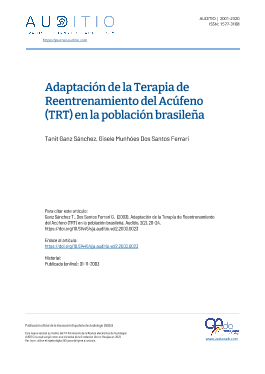Adaptación de la Terapia de Reentrenamiento del Acúfeno (TRT) en la población brasileña
DOI:
https://doi.org/10.51445/sja.auditio.vol2.2003.0023Palabras clave:
acúfenos, terapia de reentrenamiento para acúfenos (TRT), generadores de sonidoResumen
El TRT se está instaurando ampliamente en distintos centros y proporcionando los mejores resultados en el alivio de los pacientes con acúfeno. En Brasil, dos hechos contribuyen a una “resistencia” a este método: la demora a que se empiece a percibir la ‘tan esperada’ mejora y la falta de conocimiento sobre el TRT. Nuestro objetivo es describir la experiencia con el TRT en Brasil, mostrando algunas adaptaciones del método oficial. Revisamos 161 archivos de pacientes con acúfeno que han empezado el TRT. El aná- lisis de los resultados se llevó acabo 12 meses después de la indicación del TRT separando a los pacientes en 3 grupos de acuerdo con la categoría y modo de tratamiento: a) categorías 1, 3 y 4 tratados con ‘sesiones de consejos más generadores de ruido de banda ancha’ (n=38): el acúfeno ha mejorado en el 73,3%; b) categorías 1, 3 y 4 que han rechazado los generadores de ruido y han recibido ‘sesiones de consejos más sonidos ambientales suaves’ (n=74): el acúfeno ha mejorado en el 80%; c) categoría 2 tratados con ‘sesiones de consejos, audífonos y sonidos ambientales suaves’ (n=49): solo 23 han estado de acuerdo en llevar audífonos, sin embargo 16 de ellos han presentado automáticamente enmascaramiento del acúfeno y han sido excluidos del resultado del TRT. En este estudio, los pacientes han demostrado una gran restricción en usar audífonos o generadores de ruido, así que los principios del TRT tuvieron que ser reforzados a través del uso de sonidos ambientales suaves. Aquellos que han seguido el protocolo del TRT han mostrado excelentes tasas de mejora del acúfeno.
Descargas
Visibility and Altmetrics
Métricas
Estadísticas globales ℹ️
|
1496
Visualizaciones
|
1025
Descargas
|
|
2521
Total
|
|
Citas
Jastreboff PJ, Hazell JWP. (1993). A neurophysiological model for tinnitus: clinical implications. Br J Audiol, 27:7-17. 2. https://doi.org/10.3109/03005369309077884
Von Wedel H, von Wedel UC, Streppel M, Walger M. (2001). Effectivenes of partial and complete instrumental masking in chronic tinnitus. Studies with reference to retraining therapy. HNO, 45(9):690-4. 3. https://doi.org/10.1007/s001060050143
Sheldrake JB, Hazell JWP, Graham RL. (1999). Results of tinnitus retraining therapy. In: Proceedings of the Sixth International Tinnitus Seminar, ed. Hazell JP. Cambridge, UK, p.292-296. 4.
Heitzman T, Rubio L, Cardenas MR, Sofio E. (1999). The importance of continuity in TRT pacientes: results at 18 months. In: Proceedings of the Sixth International Tinnitus Seminar, ed. Hazell JP. Cambridge, UK, p.509-511. 5. https://doi.org/10.1016/S0962-6298(98)00042-0
Gold SL, Formby C, Gray WC. (2000). Celebrating a decade of evaluation and treatment: The University of Maryland Tinnitus & Hyperacusis Center. Am J Audiol, 9(2):69-74. 6. https://doi.org/10.1044/1059-0889(2000/014)
Bartnik G, Fabijanska A, Rogowski M. (2001). Effects of tinnitus retraining therapy (TRT) for patients with tinnitus and subjective hearing los versus tinnitus only. Scand Audiol Suppl, (52):206-8. 7. https://doi.org/10.1080/010503901300007542
Jastreboff PJ. (1990). Phantom auditory perception (tinnitus): mechanisms of generation and perception. Neurosci Res, 8:221-254. 8.
https://doi.org/10.1016/0168-0102(90)90031-9
Seidmann MD, Jacobsen GP. (1996). Update on tinnitus. Otolaryngol Clin North Am, 29:455-465. https://doi.org/10.1016/S0030-6665(20)30367-4
Hese G, Rienhoff NK, Nelting M, Laubert A. (2001). Chronic complex tinnitus: therapeutic results of in-patient treatment in a tinnitus clinic. Laryngorhinootologie, 80(9):503-8. https://doi.org/10.1055/s-2001-17131

Publicado
Versiones
- 2021-09-15 (2)
- 2003-11-01 (1)
Cómo citar
Número
Sección
Licencia
Derechos de autor 2003 Auditio

Esta obra está bajo una licencia Creative Commons Reconocimiento 3.0 Unported.
Todos los artículos serán publicados bajo la licencia abierta Creative Commons Attribution (CC-BY). Esta licencia permite a otros compartir y adaptar el contenido, incluso con fines comerciales, siempre que se dé el reconocimiento adecuado a los autores y a la revista. Al enviar su manuscrito, los autores retienen los derechos de autor pero otorgan a la revista el derecho a realizar la primera publicación bajo esta licencia.
Más información sobre esta licencia disponible en: https://creativecommons.org/licenses/by/4.0/
Publicaciones 2001-2020
Los textos publicados en esta revista en la seccion de "AUDITIO 2001-2020 están sujetos –si no se indica lo contrario– a una licencia de Reconocimiento 3.0 España de Creative Commons. Puede copiarlos, distribuirlos, comunicarlos públicamente, hacer obras derivadas y usos comerciales siempre que reconozca los créditos de las obras (autoría, nombre de la revista, institución editora) de la manera especificada por los autores o por la revista. La licencia completa se puede consultar en http://creativecommons.org/licenses/by/3.0/es/deed.es.








 AUDITIO | Spanish Journal of Audiology
AUDITIO | Spanish Journal of Audiology
